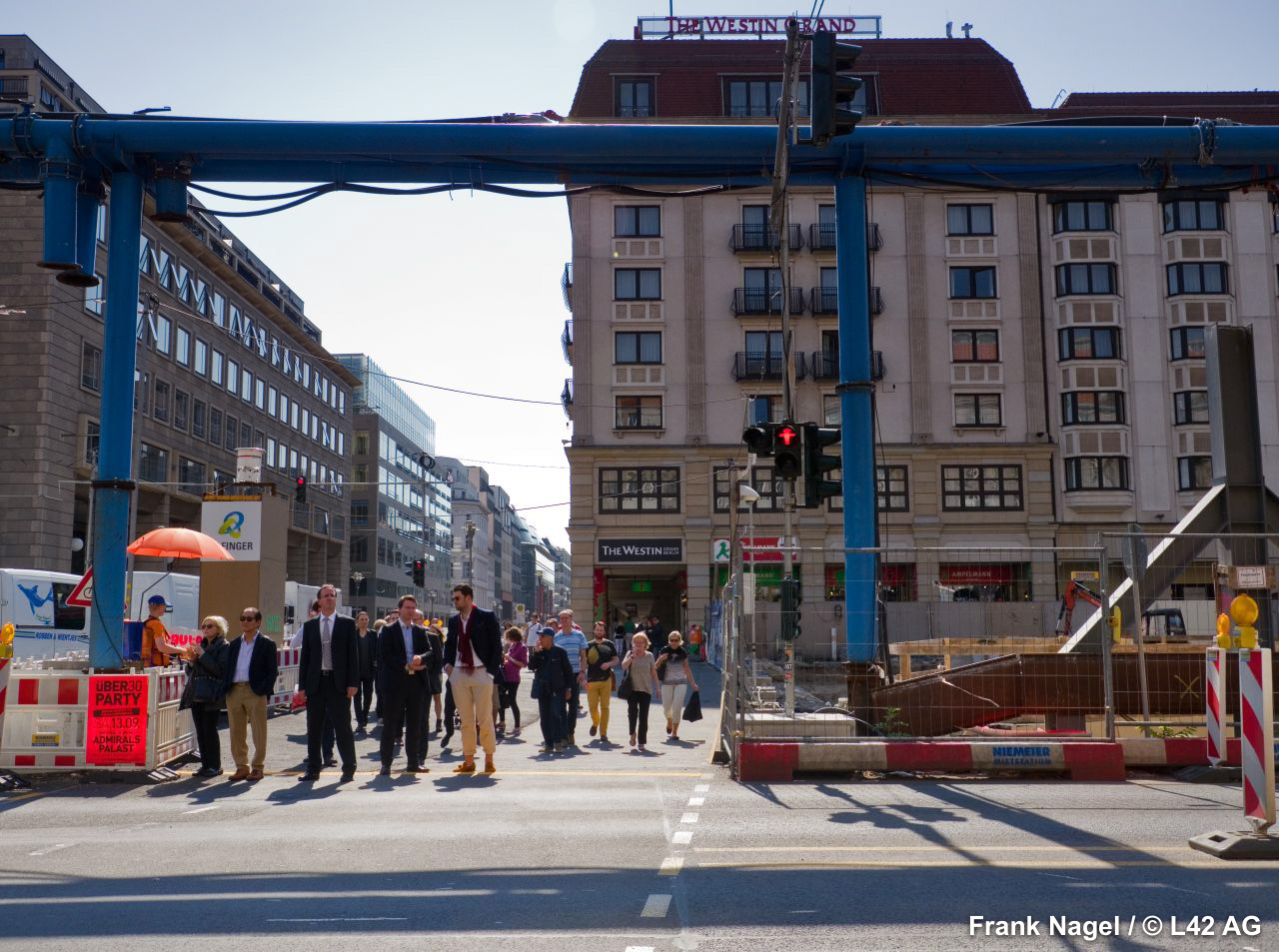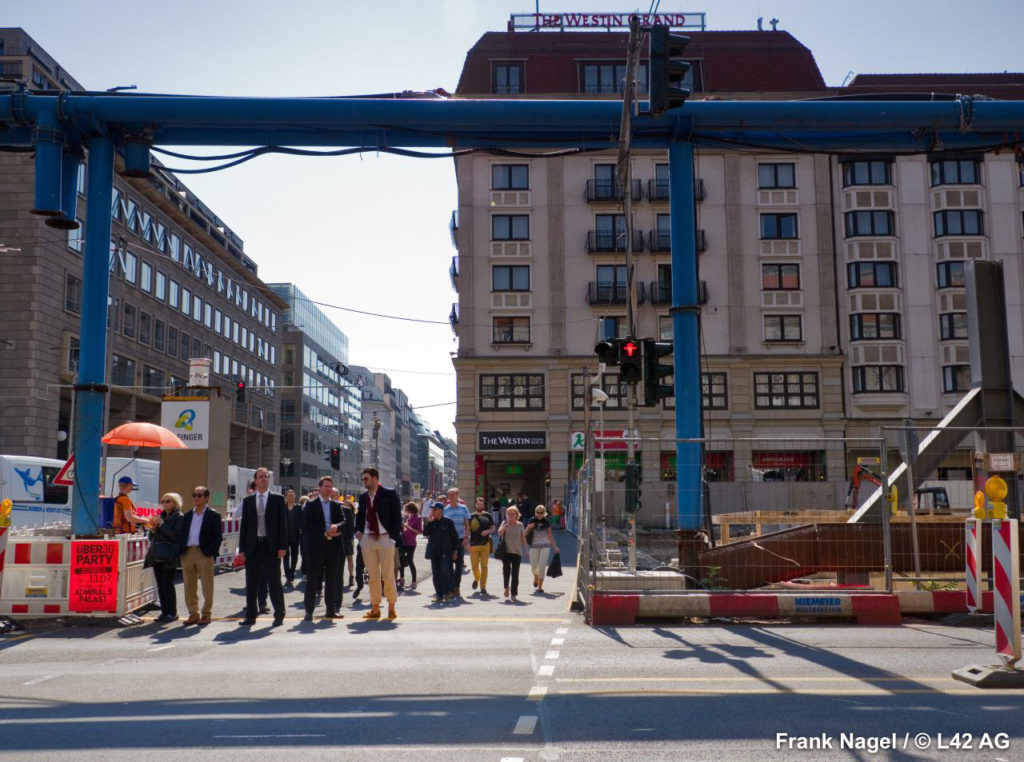
Mitte means “center” and “center” is also the name of the central quarter of Berlin which once belonged to the German Democratic Republic and today is home to many different identities. Today in Mitte there is everything and nothing, in the sense that after the fall of the Wall they suddenly discovered that it was, physically speaking, the heart of the new, as well as old, capital and in no time at all it become the new symbol to relaunch urbi et orbi. But even before this concept of philosophical speculation was born, the even fiercer force of real-estate speculation beat them to the punch. Mitte therefore became the economy around which the otherwise rather lackadaisical Berliner spirit of entrepreneurship revolved over the past two decades. But, here too, it must be stated that few Berliners count among the investors and capital. Like so many things, it is rather globalized and, like the workers, speaks Polish, Russian, and various Slavic languages quite well. For twenty years now this part of Mitte has undergone unprecedented eviscerations and restorations. Throughout all these years it seemed like everyone had been bitten by the spider of construction-hedonism. Whatever had been normal before suddenly became an old ruin to be operated upon. The symbols of the GDR were whipped with gigantic steel balls from enormous cranes and reduced to smoldering ruins. For twenty years now Mitte has done nothing but smoke and export its ashes to nearby neighborhoods. Hydrants conduct a daily battle against the clouds of pulverized buildings by attempting to keep them wet and having them fall back to earth, but they don’t always win. For this reason, in Mitte there’s always an air of pulverized earth. There’s lime, there’s cement, there’s brick, and there’s sand…In a lot of places you even breathe an air of varnish which mixes in nicely with the smell of exhaust. During the time of the GDR, the exhaust was that of the Trabant or Trabi, the East German produced car with a two-stroke engine (like a motor scooter). All the same, most people used public transportation. Now in Mitte you can find many types of, let’s say, “normal” cars (i.e. those with a four-stroke or internal combustion engine) and, yes, still a lot of people using public transportation, the difference being only that those driving are often not from Berlin. The fact that there are construction sites practically everywhere causes a fair amount of traffic problems, from lane closures to proper blocks, and therefore many vehicles are simply standing as it were in lines, with their motors running, and the fumes multiplying. It almost sounds like a nightmare and, well, it is actually, but tourists manage to enjoy themselves all the same and, anyway, who knows what other pollutants are being expelled from the earth where they come from. As far as Berliners are concerned, they’ve seen worse and tolerate it all, even if they grumble now and again. And some people even think that all of this will bring about a collective progress in civility. “We’ve re-modelled Unter den Linden just for you so that you finally will have the shopping center you deserve, so that you can spare yourselves the trouble of having to walk another fifty feet to the other wonderful shopping center we just finished. We are sorry that you shall have to be subjected to the discomfort of having to change two times a day from the U6 between Französischestraße and Friedrichstraße but you will thereby have the opportunity to inspect the work we have been completing on your behalf…”
A life without illusions would only be half as nice. The construction site on Unter den Linden makes one dream. Above all, that it will all soon be finished.
You can also enjoy Mitte, however, from on high, provided that you have an extra 20 euros. On one of the few days in the year when there isn’t any wind you could go up and down in a hot-air balloon without, however, ever leaving the ground. You go up to a height of 150 meters (close to 500 feet) thanks to a jittery motor accompanied by a preregistered voice which, as you go into the air, continues to reassure you that everything is safe, ever more safe, and when you reach the top you can see the entire city spread out before you. Then you go back down when the 22-mm-in-diameter steel cable wraps back up. If it wraps back up. As the hot-air balloon is considered a means of aerial transport, a real pilot guides us up to the top telling us how the balloon – which contains 5,500 square meters of helium – will not explode like the early ones which were filled with hydrogen. Here in the balloon the wind coming from the southeast is called the Sarotti, which is also the name of an old chocolate factory in Kreuzberg. When the Sarotti blows it brings with it an intense odor of chocolate. To learn everything about the wind of Berlin, which is different from knowing simply whether the weather is nice or not, you just need to consult the website of the hot-air balloon. As a general rule, when it’s a nice, clear, sunny day, above all during the fall and winter months, up here you can expect the afternoon to be windy because the currents of hot and cold air mix. You’ll also realize that the winds down below move about three times as slow as those at 150 meters and that much of that which takes place at the atmospheric level is due to the encounter of high pressure currents, which always move in a clockwise motion, and low pressure currents, which always move in a counterclockwise motion. Coming back down to earth, you’ll be a bit more aware of the air, you’ll most certainly feel refreshed, and you’ll remember the fundamental role distance plays in perception. In the majority of cases you’ll come back down rather disoriented too.
Now, if you were already a bit afraid of the hot-air balloon, we wouldn’t recommend you parachuting from a height of 4,000 meters. After 50 seconds of free-fall, the chute opens about 1,500 meters from the ground. The whole thing lasts between five and seven minutes and no doubt leaves a lasting impression. The economic impression it leaves is that of making your wallet 200 euros lighter, and, at the moment, low-cost variations aren’t foreseen. Information is available on the site of the hot-air balloon.
Crossing Unter den Linden at the height of Friedrichstraße you’ll notice another construction site. But “construction site” doesn’t quite give you an idea of the real dimensions of the work underway. Here almost the entire expanse of the avenue is involved. They’ve been digging away here over the last number of months and, at least here, they’re finally beginning to remove some of the scaffolding. On the street itself the cars, taxis, buses, trucks, bicycles, and pedestrians continue to move, but by means of special crossings and temporary lanes.
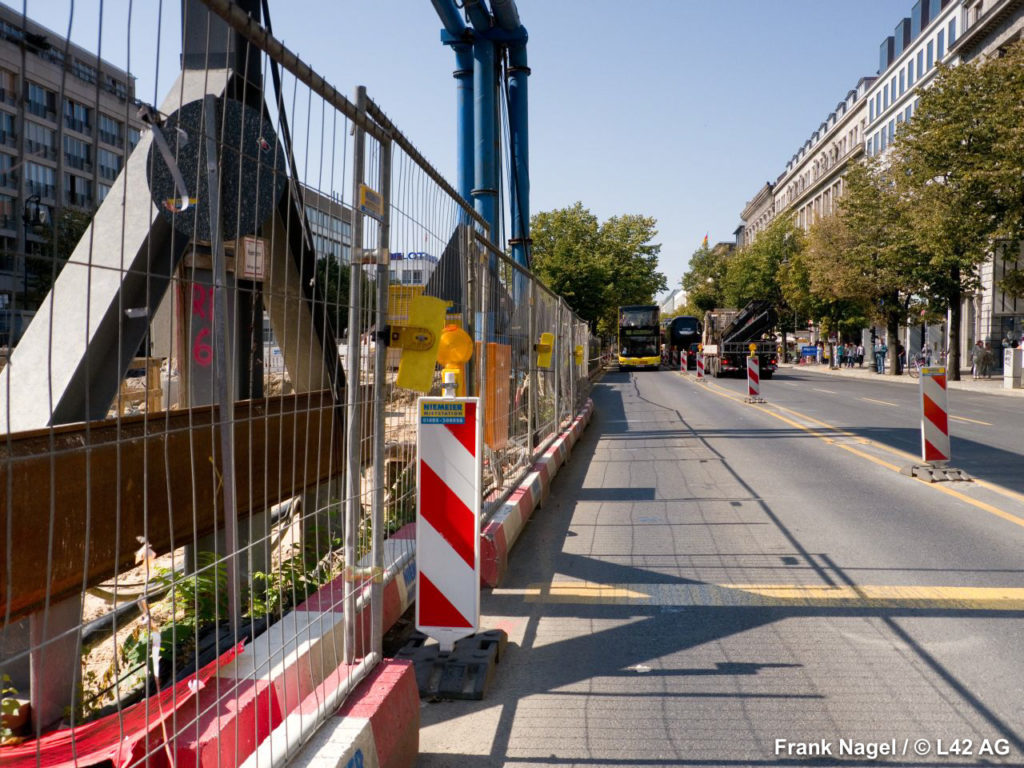
It’s loud. The construction site rattles and the construction workers have to be louder than the machines and the traffic. There’s a horn from some car that’s appeared from out of nowhere while more than one pedestrian, no longer believing themselves to be in Germany, is trying to cross against the red light. There are office workers who have come outside to breathe a bit of fresh air and are yelling into their mobile phones. There are groups of tourists trying to stay together but who, as always, have instead managed to lose someone and their tour guide is menacingly waving her umbrella in the air and whistling as if trying to expel the evil spirits but knowing full well that she has to keep the black sheep until the end of the day and, smiling, chewing away at a piece of gum as if it were coca still says “Yes, yes, don’t worry, we’ll have time to buy t-shirts later…”
So, at an intersection like this, it’s not uncommon to feel the urge not only to cross against the light but to let yourself be catapulted 800 meters away into the gardens of the Tiergarten and, more precisely, into the secret little rose garden which at least six months of the year emits the purest of fragrances. Instead, there’s just a single tourist, lost in a daydream while planted next to the barriers marking the site. His eyes are fixed on the skies, as if he were experiencing a mystic vision, where there’s a construction worker with a cigarette in the corner of his mouth controlling a crane which is moving heavy, meter-long rods of steel. Aside from that, though, what’s there to look at? Maybe he’s recently given up smoking and is looking enviously at the cigarette in the construction worker’s mouth? No, that’d be too uncomfortable, there are enough workers down here on the ground smoking. No, he’s not looking at anything in particular it seems. He’s simply smelling the air, smelling the air and dreaming. Dreaming of when he was young and would go to the seaside in the car with his parents. How hot it was, and how there was no air conditioning. When it was hot, they had to roll down the windows to breathe. But it was hot outside, too, at least fifty degrees Celsius under the sun and everyone just wanted to go to the seaside but, instead, they all found themselves bottled up in the same road, breathing the vapors from the burning asphalt…The vapors from the burning asphalt. That’s what the tourist’s doing here, forty years later, on a streetcorner in Berlin, imagining that right after the smell of the tar will come the smell of hot sand together with other pieces of tar that come and go from the sea and then he’ll finally be able to dive into the salty water of the Mediterranean…
Can an open-air nightmare really transform itself into a dream? It can. In a fraction of a second the olfactory receptors react to directly stimulate the nerve centers where memories are conserved and, with them, emotions. Here is what can happen if you just open your spirit to receiving that which passes through the nose: any olfactory moment at all can bring us back in time and we can intimately connect the present to the past. The workmen who with their blowtorches are working the stretches of tar happily confess that they no longer smell the tar anymore, but they’re annoyed by the diesel motors running at the light. And if you ask them to name just one positive smell, laughingly they pass their torches over the wooden beams and say “a fire!” And just like that you smell the perfume of the flame’s heat and a delicate note of burned wood which, together, to these workmen mean: home, Sunday, family…Now a workman who was busy elsewhere comes up to tell us his favorite smell. “Pizza! Can’t you smell that there’s a pizzeria over there?” And everyone around him laughs, but like in a silent film because the noise from the traffic and the construction site drowns out almost everything else.
Mitte’s air is constantly projected into the future. As soon as the Wall came down, the entire area immediately wanted to forget that it had once been part of the GDR. Even today there are still streets that cause you to travel back thirty years in time and ask out loud “But just a few years ago wasn’t this still the German Democratic Republic?” Fresh from their latest bout of plastic surgery the walls indignantly reply “German Democratic Republic to whom? But haven’t you noticed that we are the crème of Berlin? Have you not noticed how pure the air is here? Do you not admire the art galleries and luxury boutiques? Do you not recognize the quality of the products on display here in our Boulangeries? Yes, they do make bread, but not like any old Bäckerei. Our Boulangeries do not simply bake organic bread, but bio-dy-nam-ic bread! Have you not noticed that our chocolate is rather tart in as much as it is noble, that our Jewish restaurants are naturally kosher, and that our Turkish pastry shops are called Oriental Confectionaries?”
We’re still in Berlin, naturellement, but we now find ourselves in the streets around the Oranienburger Straße, and in particular between the Auguststraße and the Tucholskystraße, in order to breathe a bit of that nouvelle noblesse a la Berlin.
Among the most precious chemical agents that the history of humankind has gotten to know is sodium chloride. Since ancient times it has been a symbol of wealth and myths and legends confirm its importance. At one time, being in possession of salt meant enjoying the possibility of conserving perishable goods and thus ensuring long life and happiness. In the Auguststraße 89 we won’t find a salt mine, no, but something pretty close: it’s called Saltero, and it’s a Salt Spa. Let us go inside. We won’t do it for our sakes, but for that tourist back on Unter den Linden. We want to see if this could prove to be a surrogate sea for him, even if here we’re not dealing with sea salt but with salt crystals.
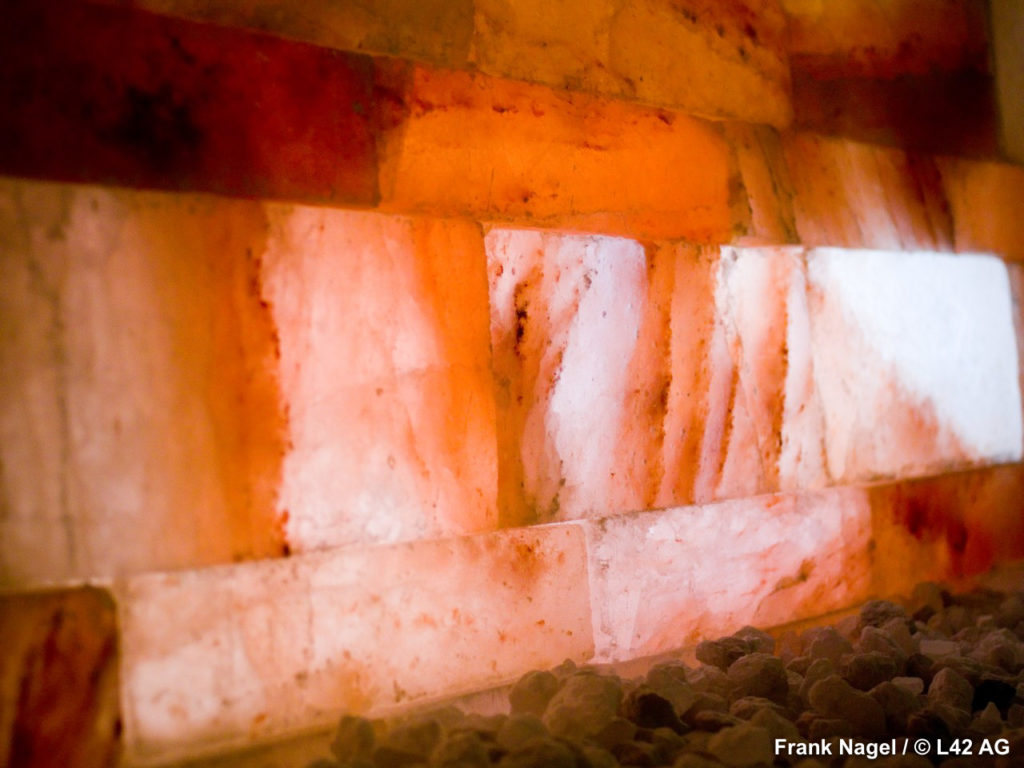
People with bronchitis, asthma, and allergies in general (as well as good old office workers who want to have a nap during their lunch break), come here to Saltero to breathe its salt air. For ten euros you can enter into a room with a ceiling of salt, walls of salt, lamps of salt, and a floor of salt. Once there, you can lay down on a beach chair of salt next to a generator of salt, or rather, a machine which pulverizes the sodium chloride into the finest of particles for us to inhale. The New Age music in the background is also pretty crystalline and we immediately feel happily dazed and, little by little, ever more flavorfully relaxed. We begin to thank our lord for having given us the possibility to have this experience and can’t imagine wanting anything else from life. Licking our lips we taste that they’re full of salt. Every three seconds we’re recovered in salt, our clothes, our hands…Continuing to lick our lips we think about those poor folks who go absolutely crazy for popcorn, potato chips, prosciutto crudo, and those who subject themselves to costly and tiresome vacations at the seaside with their mother-in-laws just to have this same taste upon their lips. The salt is starting to hurt our eyes a little bit now, just like when you dive into the Mediterranean Sea. Let’s close them and think about the tourist again. Oh how happy he’d be! Now our nostrils are beginning to be a bit dry. Our lips are still salty, though. Ah, the salt of life! You feel regenerated. It’s as if this substance were both heating and cooling your lungs at the same time. The salt smells fresh and dry. Fresh like a strong breath of air. We could even die this way. What would it be like on the other side with a coffin made out of salt, a salted tomb, and all of our friends happily covered in salt?
Unexpectedly a Russian voice announces in German that our 45 minutes are up and that it’s time for us to leave. We awake with a start and feel something moving in our lungs, something like when we were sickly kids and sometimes had to use an inhaler but here there was this lovely music and, on top of it, we were spread out and even had a quick little nap and now, our hair full of salt, we can go back outside as happy as clams. With this prana dancing inside of us we could go anywhere, we could even jump like a cat to the top of any one of these three-story pastel buildings and cry “Berlin! Berlin! How like the Himalayas you are!” The gallerists at their desks no doubt wouldn’t even bat an eyelash. They would simply lower their fuchsia colored bifocals to the point of their noses, raise their eyes, and sigh “Ah…an installation.”
Instead of jumping to the top of any buildings, however, we’ll walk into the first noble chocolatier we find, which happens to be at Linienstrasße 140. It’s called Atelier Cacao, and for good reason. Here nut, brown, and cream colored sculptures of chocolate greet us warmly. The chocolate is organic and one 100 gram bar costs more than 4 euros. Naturally, there are also “creations,” but that’s another story. You could say that it isn’t exactly a democratic place, but the chocolate is truly exquisite. You cannot smell the sweet smell of chocolate made from ordinary milk. Here we discover that that what we usually refer to as chocolate is really just milk and sugar. Real chocolate has a very particular odor and tastes of toasted grass and is just a little bit bitter. We remember now that chocolate was primarily an Inca creation, an aristocratic ritual food that brought one closer to the gods and that only later was turned into an industrial, Swiss, and popular one. Here in this shop we can sense the compactness of the quality, the delicate and fresh aroma, and imagine ourselves close to its very essence. We’d like to run out, jump to the top of one of these buildings and cry “Berlin! Berlin! How Inca you are!” The gallerists sat at their desks no doubt wouldn’t even bat an eyelash. They would simply lower their fuchsia colored bifocals to the point of their noses, raise their eyes, and sigh “Tacheles?”
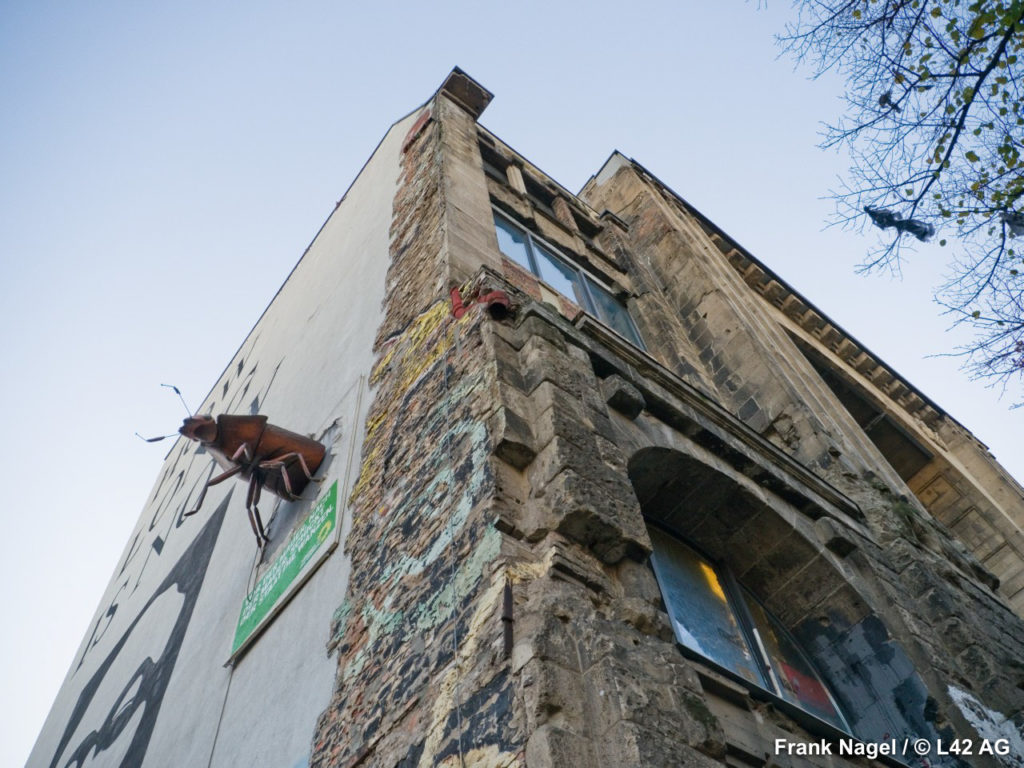
No, Tacheles doesn’t exist anymore. Or rather, you can still see the old edifice of the former artists’ squat on Oranienburger Straße but it’s definitely that of the last hold-outs after years of discussions between politicians, sociologists, architects, and occupants. A piano, two artists dressed in black, a funeral oration. That was how it all ended on September 4, 2012. Just a crowd of police and journalists.
But what was it exactly? “Tacheles” – a Yiddish word that means “straight-forward talk” – was an artists’ collective and arts center formed in 1990 in the ruins of a former department store. The building – which then became known simply as Tacheles – was erected in 1907 and before becoming the permanent seat of the artists had gone through a number of different hands throughout the twentieth century. Every year Tacheles received more than 500,000 visitors from all over the world and was home to 30 ateliers and about eighty artists from over 30 different countries. People could visit the exhibition spaces, take part in free performances, and make statues from out of the ruins. The whole building was painted in bright, lively colors. However, the lease for the building which had been given to the artists for a symbolic fee ran out and the new owners had different ideas for its future. At a few points it seemed as if the Tacheles might be immortal, but, in the end, after a good fight, the liveliest center of contemporary art in the new Berlin passed away. Many of the artists have since moved their operations to the Alte Börse (the Old Exchange) in the working-class district of Marzahn, between fields and Plattenbauten.
On Oranienburger Straße today you breathe an air of calm, but almost unreal, emptiness. Tacheles today is a multi-colored cadaver rained upon day after day by the pigeons while the streets around it are all new and clean and almost all traces of what once was here that might have provided a counterweight to the static-nature of the renovated city have been removed.
In the immediate vicinity of the Oranienburger Straße everything is also nice and tasteful and the only thing missing is our complaining about it. From the former Barn Quarter filled with questionable characters, to the Jewish quarter made up of Jews who had left Eastern Europe, to the ghost quarter full of the wounds of war during the GDR, today this area is relaxed and wholesome. It’s very international, and less multi-cultural.
The Turkish pastry shop on Linienstraße is called, for example, Confiserie Oriental Istanbul-Berlin and has a fresh, Provencal-like air. The decor is almost completely white, and is bordered by lines of gold and flowers. The tea is extremely fragrant, the lokum or Turkish Delight – those confections of honey covered with chips of coconut or walnut or hazelnut or pistachios – are displayed like jewels and are extremely delicate both in their smell and on the palate. It’s like being on a cloud. A Turkish cloud from a celestial Turkey. The Turks here drinking their tea have the air of art dealers. This Oriental café is so quiet that this time we’re not tempted to jump to the roof to yell “Berlin! Berlin! How Oriental you are!” No, this time we’ll follow along the snow-white wall and whisper without barely moving our lips so that no one can hear. “Berlin, Berlin, que tu es oriental..:” But the gallerists sat at their desks no doubt at the very moment would lower their fuchsia colored bifocals to the tips of their noses in order to read our lips and raise their eyes to us to sigh simply “Eh oui…”
We are now at the intersection with Tucholskystraße and shall simply follow the smell of bread which will bring us to Number 31. The bread here is by no means normal. It is biodynamic and baked in a wood oven and the store is called Wiener Brot (Viennese Bread). But “Berlin! Berlin! You are so Viennese!” won’t work at all. The bread is really good, though.
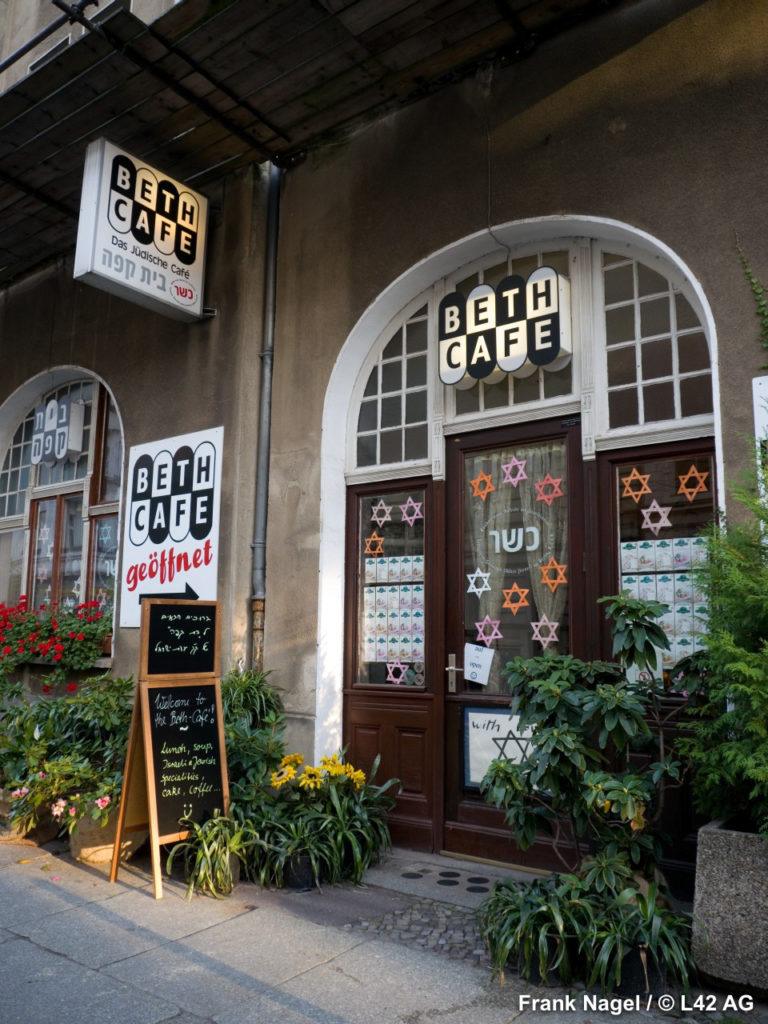
Our olfactory path, however, shall finish at Beth Café (Hebrew for “coffee house”), the well-known Kosher restaurant of Berlin. You have to go to Beth Café twice, however, for one time’s simply not enough. The first time you’re quite comfortable and the second time, too, but you don’t know why so you’ll have to come again a third time…This is an Israeli restaurant and, considering that Berliner Jews mostly come from Russia or from the former Soviet states, at Beth Café, above all, you’ll encounter Jews who are not from Berlin.
There’s truly a unique air to this place. First of all, you are not allowed to use mobile telephones or to take photos and this already makes the air rather different. The customers are all well dressed and speak in low voices. Some of the men coming inside wear kippahs and rinse their hands in the small basin at the entrance, pouring the water from a pitcher. The café is decorated with a refined sense of elegance, but it feels as if you were at home or perhaps a guest in the dining room of a well-to-do family in the early 20th century with fine white porcelain in dark bureaus, dried bunches of lavender, sofas in red velvet, brown chairs, Venetian flooring, and a glass door looking onto a room with an old piano…
A man with round glasses, white hair sprouting out from his kippah, a white shirt, a black vest, and black trousers calmly sits down at a table where there is an extremely well-behaved little girl who looks like she has just gotten out of school, her wavy, honey-colored hair pulled back in a clip, doing her homework. The smells here are neutral or come in small, delicate bundles like an aromatic rainbow. On the walls there are photos of Jewish life in Israel while very low in the background you can hear the sounds of traditional Jewish music. There is the pervasive trace of vinegar, now a hint of beans, then a whiff of ginger, but it’s as if the different fragrances have all managed to maintain their own identity. More than anything the coconut and carrot soup gives off an intense smell of parsley and then, little by little, the other ingredients arrive, but never in an aggressive manner. We don’t know if the reasons for all this harmony are to be found in Kosher cooking and life, but one thing’s for sure: the air here is good.
Kosher cooking is governed by numerous rules. The most well-known is perhaps that which dictates that dairy and meat must never be mixed. Another rule regulates the meat that can be used: fowl, sheep, goat, and cow but in the traditional Kosher manner which doesn’t cause the animal to suffer. As far as fish is concerned, only those with scales and bones are allowed. Here in the Beth Café they normally only serve “pareve” food i.e. foods that are neutral and do not contain either dairy products or meat. Hence the absence of almost all the odors of animal fats here that you would likely smell eating, say, typically German food. Simply nominating a porkchop or a Bratwurst here in the Beth Café would likely be tantamount to an insult. If you want to find a bit of fresh air in Berlin you can come here to breathe in a bit of hummus, that wonderful chickpea paste you put directly onto pita bread, without using any cutlery, and which you first bring to your nose, and then your mouth. Rice with lentils is a perfect match: the rice proudly remains rice, the lentils remain lentils, and we remain happy. The eggplant fried with tomatoes is as simple as it is delicate and delicious, in spite of being fried. The beans with garlic and parsley are a wonderful trio with the garlic that first burns your nostrils and then your stomach. Then there are the classic green peppers soaked in vinegar that are typical to Mediterranean cooking. The peppers smell more like peppers than vinegar and, as they are placed on a slice of real, sweet Israeli orange, they even smell slightly sweet. It’s amazing what you can do with the simplest ingredients of excellent quality when done with love and intelligence. Even a single slice of sweet orange can brighten your day.
Last but not least, we’ll drink a homemade mango liquor. The alcohol goes down warm and the mango is fresh and we leave the Beth Café vibrating happily. We might even say that we feel kosher, but such comments always risk being misinterpreted and causing discomfort. There are always two policemen in front of the Beth Café just like there are at the adjacent synagogue and at the entrance to the New Synagogue of Oranienburgerstraße, which also has a metal detector. This aftertaste of such a troubled region always leaves us sad and wondering whether the world will ever find peace. © L42 AG
Translated by Alexander Booth
